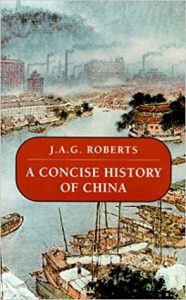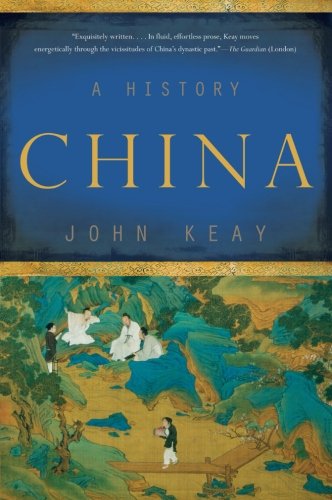 Keay, John. China: A History. New York: Basic Books, 2009.
Keay, John. China: A History. New York: Basic Books, 2009.
Roberts, J.A.G. A Concise History of China. Cambridge, MA: Harvard University Press, 1999.
Some months ago, as Francis and I were discussing a potential piece for the blog, I realized I needed to brush up on my grasp of Chinese history. Perusing the shelves of my local library, I happened upon two promising volumes. The first, China: A History, was penned by esteemed journalist John Keay, while the second, A Concise History of China, was written by English academic J.A.G. Roberts. Faced with a more public, accessible volume on the one hand and an academic’s historical survey on the other, I decided to read them both and then compare them in a rare tandem review.
To begin, it must be said that I thoroughly enjoyed both of these works of history. Keay and Roberts are clearly masters of their material, and both relate the history of China and its people in clear, elegant prose. As I alluded to in my premise, I am admittedly not very familiar with the field of Chinese history, but to my limited knowledge no information in either book was factually inaccurate or mistaken. Similarly, I have little or nothing bad to say about either; simply recognition of stylistic differences and and things one did better than the other. The most visible and fundamental of these differences (other than the backgrounds and training of their authors) is their respective lengths. In a bit of a twist, Keay’s non-academic work is more than two hundred pages longer than Roberts’s. This wealth of space is even more evident in the comparative space reserved for certain topics. Keay takes one hundred and sixty pages to cover the events of Chinese history to AD 224 (collapse of the Han Dynasty), while Roberts takes just forty. Keay himself recognizes just how much time he spends on pre-modern China, noting that while some histories seem to fly by until they reach the modern era, whereupon they slow to a crawl, his in fact does the opposite. Keay’s statement seems to directly address Roberts, who, after showing surprising early brevity, then proceeds to devote the last hundred pages of his work (fully one third of the total) to just the years 1911-1997. This is certainly a more conventional and, to a degree, more understandable approach, as sources and documents become increasingly numerous and well-preserved as we approach the present. The events of the past hundred years of Chinese history have certainly been tumultuous, yet Keay opts for a restrained approach. Summarizing major events and trends rather than giving a socio-political blow-by-blow serves to emphasize that China has experienced periods of intense upheaval and radical change before, and the impact of this century should not be given undue weight simply due to our proximity to it. Readers seeking to understand modern China through its history may understandably prefer Roberts’s approach to Keay’s; personally, I greatly appreciated the latter’s longer perspective. Read together, the two books complement each other perfectly.
It will perhaps come as no surprise that, despite being much longer, Keay’s non-academic work is generally more engaging than Roberts’s. China: A History follows a definite narrative structure as Keay uses themes of Chinese philosophy and preoccupation with their own history to both ground his work and move it forward. The result is a history that simultaneously relates the events of China’s past within their cultural context and demonstrates the manner in which contemporary Chinese may have processed those events’ implications. Plainer in its recounting of the facts, A Concise History of China meanwhile can read like a text assigned for a mid-level college course. Each approach comes with its own strengths and weaknesses. Keay is at times not as critical of his sources as he should be, while Roberts on a whole handles primary sources with more skill and explicit discussion. Keay is able to weave entertaining vignettes into his grander narrative, while Roberts’s topical interludes can appear abrupt and isolated. Roberts’s background in academic history is almost assuredly responsible for this and other minor but noticeable differences. Roberts admirably discusses the basics of Chinese historiography with his readers, summarizing historians’ debates and their impact on our understanding of certain issues; such a concept is utterly absent from Keay’s narrative. Roberts’s claim to present a truly introductory text does not quite ring true for much the same reason, however. While Keay takes care to introduce his readers to each important figure and concept as they first arise (such as his opening discussion of basic Chinese geography), Roberts’s style can lead to all manner of crucial terminology simply appearing in the text with little background for those who have never encountered it before to understand its importance.
For all their differences, these two histories share the same major deficiency, or, perhaps more appropriately, an unavoidable weakness. A single volume history encompassing the entirety of China’s past is a tall order, and must necessarily look to China’s high politics as its guiding theme. Thus, while both Keay and Roberts do discuss some social and cultural elements of Chinese history, their treatments consist overwhelmingly of classic political and economic history, if written with more current sensibilities. What non-political elements are discussed are furthermore done so from such an elite or lofty perspective that, while it is also arguably unavoidable, gives either only a portrait of life at court or a broad picture of trends and statistics as they become relative to the political narrative rather than a concrete image of, say, the evolving lifestyle and experiences of peasant farmers. These are no ‘people’s history’ of China, though admittedly neither billed itself as such. Less a critique and more of a frank appraisal, then, I offer this simply as a warning to any looking to appreciate a more grassroots or cultural history of China: these are not the books for you.
If forced to choose between these two impressive volumes, I would be forced to admit that I ultimately enjoyed John Keay’s China: A History the most, a surprising revelation from an historian who almost always leans more academic. Yet this is only personal preference rather than a pronouncement of quality, and one’s own preference will depend on what you’re looking to get out of your reading. Hoping to read the story of China? Keay’s your man. Searching for a guide in making sense of modern China and its place in the word? Go with Roberts. One thing’s for certain: you can’t go wrong with either.
